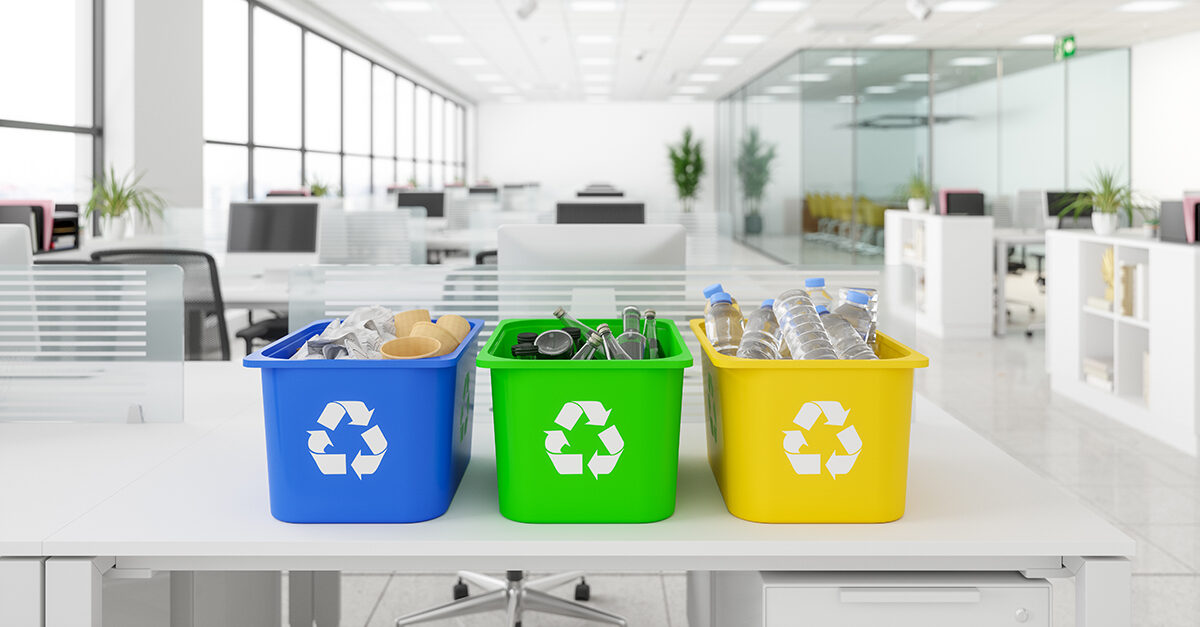Before the COVID-19 pandemic hit, facility managers already faced substantial challenges to their recycling programs. Market turmoil as China stopped accepting recycled goods from the United States, increased contamination, and the constant challenge of anticipating public behaviors left many recycling programs scrambling to find solutions year
after year.
Since the spring of 2020, recycling has faced another set of barriers as people stayed home, companies slashed budgets, and new materials were introduced to the waste stream in massive quantities. Facility managers needed to get creative to adapt their recycling programs to a new set of challenges, while keeping up with the old ones, too. Below, we take a closer look at some of these setbacks along with a few creative solutions to help you get your recycling efforts back on track.
Remote recycling woes
Institutions like colleges, K-12 school districts, corporations, and hospitals have spent decades building programs that made it easy for employees and students to practice effective recycling behaviors. When workers and students began spending their days at home, they brought about a change in public behavior. Brian Johnson, director at The Ashkin Group, a sustainability consulting group, has seen a fundamental shift in recycling trends that begins with work-from-home practices.
“We all went home and took our environmental footprints with us,” says Johnson. “Otherwise we would have been working at offices and our solid waste would all be subject to these commercial organizations, which are more effective than most residential systems. Now you see these boosts in household recycling waste and the lessening of commercial recycling waste across the board.”
The ramifications of that shift are practical and operational. First, Johnson sees an increase in waste stream contamination. Without the handy signs provided by our workplaces telling us where to throw away things, we’re left to figure out what to recycle on our own. “And we don’t do a good job recycling at home in terms of knowing what is recyclable and also preventing contamination,” says Johnson. “At home, items may need to be emptied, cleaned out, and dried first, too.”
Equipment used to collect commercial waste is different from what is used to collect residential waste, so items that were recyclable in the workplace may not be recyclable at home. However, people will need to do their own research to figure that out. When the Office for a Healthy Environment at Cleveland Clinic realized that their recycling waste was diminishing because all of their administrative employees were working remotely, they developed an online platform to educate employees about how to recycle at home. Jon Utech, senior director of the Cleveland Clinic Office for a Healthy Environment, notes that the main challenge during a shift to remote work is that the onus is on the individual to seek out information from their community-based recycling programs. He took the opportunity to talk to Cleveland Clinic administrative staff about reducing waste, rather than getting hung up on the nuances of their varied community residential recycling systems.
“Individuals need to take the time to read and understand their local recycling guidelines and ensure their waste is of the highest possible quality,” says Utech. “So we did some education on closed-loop consumer products around our Plastic-Free July challenge to help offset some of the obstacles that come from a shift to residential recycling programs.”
Budget and labor shortages
In a traditional waste management system, a trash bin and a recycling container sit in each office, classroom, or vestibule and get emptied by a custodian every night. The pandemic has caused institutions to step back and rethink that system, with some inadvertent benefits to
recycling outcomes.
Centralized collection systems remove deskside bins in favor of one communal bin system placed at a strategic location. Eliminating the custodial task of servicing individual bins proved essential in a year when labor shortages and an increased demand for new infection prevention tasks dominated facility management. Centralized collection systems can also reduce waste, decrease contamination, and increase recycling rates. That’s largely because centralized collection systems are more clearly labeled, making sorting easier and heightening public awareness.
Last fall, Alec Cooley, a senior advisor at Busch Systems Consulting who has been studying recycling behaviors for the past 20 years, surveyed 130 colleges and universities across Canada and the U.S. to determine how the pandemic affected their recycling programs. Cooley notes how the survey illuminated the ways COVID-19 is helping to accelerate the trend of centralized collection. “The results revealed a much larger number of schools are doing it than I would have guessed,” he says.
According to the survey, 20% of respondents have shifted or are actively considering the shift to centralized collections. The reasons are twofold; 29% of respondents had to accommodate significant labor shortages after they cut recycling staff positions. Other respondents had to divert staff from recycling duties to cleaning and disinfecting tasks.
“If you can propose changes that connect the school with its bottom line, saving cost and labor, you can demonstrate the change can help that problem along with waste reduction strategies,” says Cooley. “There’s an opportunity to go farther than you could in the past, and the increase in centralized collection, which boosts recycling programs, could be a silver lining of the pandemic.”
New materials in the waste stream
There’s no doubt we are using more disposable products now than we were in 2019. Hand sanitizer, masks, gloves, plastic face shields, and food takeout containers are all single-use items we’ve had to figure out how to dispose of, and they may be here for a while longer. What does that mean for recycling? Many facilities had to get creative about how they source materials, scheduling follow-up visits with recycling vendors to monitor the waste stream. In some cases, they chose to prioritize infection prevention over recycling goals.
Hand sanitizer was in high demand in the spring of 2020. For Cleveland Clinic, hand sanitizer was also absolutely necessary. Not wanting to risk a shortage, the clinic entered a closed-loop system with a local distiller, Cleveland Whiskey Company. The distillery sent drums of hand sanitizer to the hospital so it could fill its own dispensers on campus, demonstrating that local supply chains are not only crucial for navigating tricky markets during a pandemic but also in finding creative solutions to reduce waste.
Utech’s recycling vendor has been sending weekly reports detailing the quality of recycled content they collect so the Office for a Healthy Environment can monitor how some of the new waste materials are showing up in the recycling facilities.
“We update our educational materials around the ways we see problems at the vendor,” says Utech. “For a decade our push was to recycle everything you can. Now we are focusing on quality versus quantity.”
Everyone’s been eating more takeout food this past year, which means to-go containers are showing up in the recycling stream, whether or not they are empty, clean, or dry. That means more opportunity for contamination.
“At first, there was a knee-jerk reaction among dining staff to dismantle programs with reusable containers and make everything disposable,” says Cooley. “In the beginning of the pandemic, we were trying everything in an attempt to be as safe as possible.”
According to Cooley’s survey of recycling staff at colleges and universities, 30% of schools temporarily suspended reusable to-go food container programs, even as 8% were working to introduce or expand such programs.
Now, Cooley is noticing that many of these colleges and universities are pushing back against the initial reaction to eliminate reusable container programs. The science on virus transmission is catching up to people’s behaviors, and sustainability programs are bouncing back.
Other solutions beyond reusable takeout containers include compostable boxes, utensils, and paper products. However, Johnson of The Ashkin Group warns institutions about jumping too quickly into the procurement of compostable food containers. To adapt to a new type of material, a facility will need an in-depth understanding of its life cycle. Facility managers will use this information to create educational programs and signage to ensure that compostable containers aren’t just an expensive plan that increases contamination in the recycling bin.
“I take a life cycle assessment view,” says Johnson. “For the most part, these bioplastic, biodegradable, compostable containers and plastics can pose a problem because once they are in the waste stream you can’t see what it is. Plus, there are public health and environmental impacts associated with the manufacturing of those products.”
Johnson recommends speaking with your recycling and composting vendors to ensure they can support bioplastics. The next step involves a pilot program to test any new biodegradable products, like compostable utensils or to-go containers, to help you understand where they end up.
As we look to the future of commercial recycling programs, it’s clear that many of the changes brought about by the last year are here to stay. Recycling is a global market with global challenges and global ramifications. We can learn from each other as we adapt to this new landscape.



